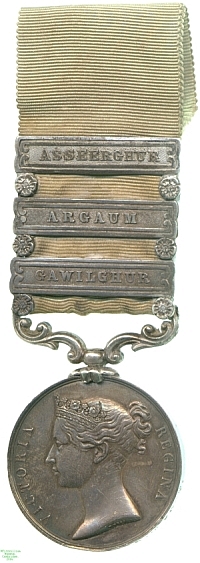
Obverse, a bust of Queen Victoria

Reverse, Victory seated facing left before a palm and war spoils, holding a laurel branch and wreath

Obverse, a bust of Queen Victoria |

Reverse, Victory seated facing left before a palm and war spoils, holding a laurel branch and wreath |
The numerous campaigns of the forces of the British East India Company were not officially recognised with a medal until 1851, in the same move as that which created the Military and Naval General Service Medals for service in the contemporary French Revolutionary and Napoleonic Wars. The resulting Army of India medal covered battles from 1799 to 1826, so many of those involved were no longer living. Queen Victoria, by whose order the medal was issued and whose bust it therefore carried, was likewise not on the throne for the actions for which it was awarded.
The Maratha Empire, a Hindu confederacy which began in 1674, had in 1796 fallen into the hands of the Peshwa ruler Baji Rao II. A rebellion by Subadar Holkar VI of Indore in 1802 defeated his forces and the Peshwa forthwith concluded a treaty with the British East India Company, trading territory for protection. Baji Rao's subjects greeted this with outrage and rebellion ensued. Among the rebels were the Bhonsle rulers of Nagpur and Berar, whose forces attacked a British column from their fortress at Aseerghur, which the British then took after an hour's bombardment without a fight, and were defeated in a rather less certain battle at Argaon (Argaum as the bar has it). The British force responsible, under Sir Arthur Wellesley, later Duke of Wellington, went on to take the supposedly impregnable fortress of Gawilghur.
This medal was awarded to R. Crawford of the 94th Foot; his name is on the Roll of those awarded the medal, and he was also entitled to a Military General Service Medal with three bars. Lester Watson purchased this medal from the London dealer Baldwin in 1928.